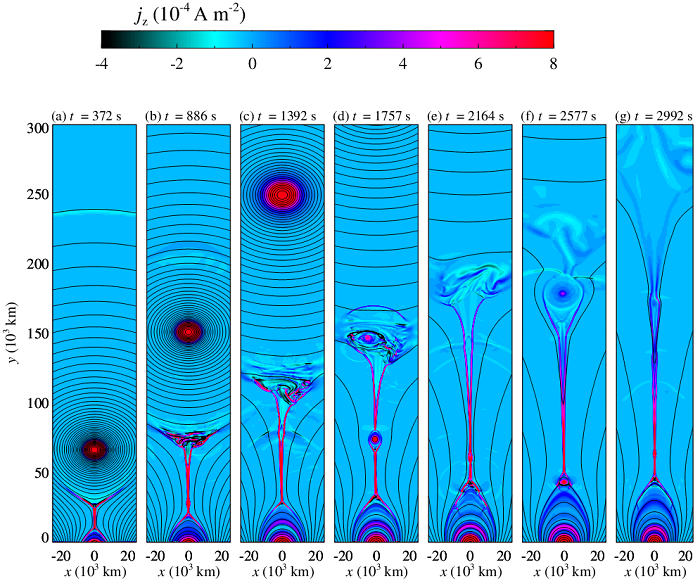XIE Xiaoyan, a PhD candidate of Yunnan Observatories of the Chinese Academy of Sciences, and her collaborators investigated the dynamic evolution in the CME-flare current sheet (CS) via numerical experiments. The results show several interesting structures that have not been noticed previously and have been published recently in the journal of Monthly Notices of the Royal Astronomical Society.
In major solar eruption, a largescale CS develops connecting solar flare to the associated coronal mass ejection (CME). Magnetic reconnection occurs in the current sheet, converting the magnetic energy into heating and kinetic energy of the plasma. It constitutes the kernel structure of the energy conversion in the most violent eruptive phenomenon in the solar system. Investigations of CME-flare CSs not only helps understand the fundamental property of the energy conversion in the eruption comprehensively, but also reveals the information regarding fine geometric structures inside the current sheet that are essential for the energy conversion.
On the basis of the catastrophe theory of the solar eruption, researchers explored details of the dynamic evolution in a CME-flare CS via numerical experiments (see Figure 1). They found that during the evolution, the disrupting magnetic configuration becomes asymmetric firstly in the buffer region at the bottom of the CME bubble. The Rayleigh-Taylor (RT) instability in this region, associating with the termination shock (TS) at the bottom of the CME bubble, invoked the oscillation of the buffer region around the symmetric axis. Propagation of the oscillation downward through the CS yielded a wavy shape of the CS. As the buffer region grew, the oscillation period became longer from about 30 s to about 16 mins. Meanwhile, another separated oscillation occurred with a period between 0.25 min and 1.5 mins in the cusp region above the flare region generated by the velocity shearing.
In addition, the tearing mode instability caused the formation of magnetic islands/plasmoids inside the CS. The motions of all the plasmoids observed in the experiment accelerated, which implied that the largescale CME/flare CS itself is indeed a largescale diffusion region according to the standard theory of magnetic reconnection.
The significance of this work is that the confirmation, for the first time, that the RT instability occurs in the buffer region due to the plasma accumulation, resulting in oscillation or lateral movement of the CME-flare CS in observations. Furthermore, unlike the scenario described in the classical magnetic reconnection theory that the diffusion region only covers a small fraction of the current sheet, the diffusion region in true eruptive events could extend to a large scale, even fill the whole CS.
Contact:
XIE Xiaoyane, YNAO, CAS
xyxie@ynao.ac.cn

Figure 1.Current density distributions (the color shading) and magnetic field lines (the black solid curves) around the current sheet at seven instances during the eruption.( Image by XIE Xiaoyan)